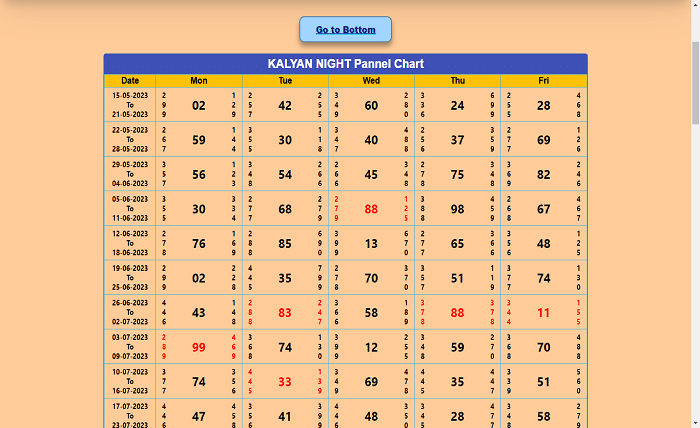Patti Chart: Your Ultimate Guide

Introduction
The Patti Chart is a vital tool in the realm of financial trading and analysis, especially in the stock and commodity markets. Understanding the Patti Chart can significantly enhance your trading strategies and improve your ability to predict market movements. This guide will walk you through the essentials of the Patti Chart, helping you to use it effectively.
What is a Patti Chart?
A Patti Chart is a graphical representation used primarily in financial markets to track and predict price movements. Originating from traditional trading methods in India, the Patti Chart helps traders identify patterns and trends. By analyzing these patterns, traders can make informed decisions, making the Patti Chart an indispensable tool in trading.
History and Origin of the Patti Chart
The Patti Chart has deep roots in Indian trading practices. Historically, it was used in traditional markets to track price fluctuations of commodities and stocks. The name “Patti” translates to “strip” in Hindi, reflecting the chart’s design, which consists of lines or strips representing price movements. Understanding this history adds depth to its usage in modern trading.
Components of a Patti Chart
To master the Patti Chart, it’s crucial to understand its components. The chart typically includes price levels, time intervals, and trend lines. Each component provides specific information about market behavior. Knowing how to interpret these elements is key to leveraging the Patti Chart effectively in your trading strategy.
How to Read a Patti Chart
Reading a Patti Chart requires a keen eye for detail. The chart’s strips or lines indicate price changes over time. By observing the direction and length of these lines, traders can identify trends, support and resistance levels, and potential breakout points. Mastering this skill can significantly enhance your market analysis.
Benefits of Using a Patti Chart
The Patti Chart offers several benefits for traders. It provides a clear visual representation of market trends, making it easier to spot potential trading opportunities. Additionally, the Patti Chart’s historical data can help traders backtest strategies and refine their approaches. Understanding these benefits underscores the chart’s value in trading.
Common Patterns in Patti Charts
Patterns are the heart of the Patti Chart. Recognizing common patterns such as head and shoulders, double tops and bottoms, and triangles can provide valuable insights into market behavior. These patterns often signal potential reversals or continuations in trends, making them essential tools for traders using the Patti Chart.
Strategies for Trading with the Patti Chart
Developing effective trading strategies with the Patti Chart involves combining pattern recognition with other technical indicators. For example, traders might use moving averages or RSI (Relative Strength Index) alongside the Patti Chart to confirm signals. Integrating multiple tools can enhance the reliability of your trading decisions.
Case Studies of Successful Trades Using the Patti Chart
Examining case studies of successful trades can provide practical insights into using the Patti Chart. These examples highlight how experienced traders have utilized the chart to predict market movements and achieve profitable outcomes. Learning from these real-world applications can inspire and inform your trading approach.
Tools and Software for Creating Patti Charts
Numerous tools and software options are available for creating and analyzing Patti Charts. Platforms like MetaTrader, TradingView, and specialized apps offer features tailored to Patti Chart analysis. Choosing the right tool depends on your specific needs and trading style. Familiarizing yourself with these options can streamline your charting process.
Challenges and Limitations of the Patti Chart
Despite its advantages, the Patti Chart has limitations. It can sometimes provide false signals, and its effectiveness may vary across different markets and timeframes. Recognizing these challenges and knowing how to mitigate them is crucial for using the Patti Chart successfully. Being aware of its limitations can prevent potential pitfalls in your trading.
Future Trends in Patti Chart Analysis
The field of Patti Chart analysis is continually evolving. Emerging technologies such as AI and machine learning are beginning to influence how traders use and interpret these charts. Staying updated on these trends can provide a competitive edge, ensuring that your trading strategies remain cutting-edge and effective.
Conclusion
The Patti Chart is a powerful tool for traders looking to enhance their market analysis and trading strategies. By understanding its history, components, patterns, and applications, you can leverage the Patti Chart to make informed and profitable trading decisions. While challenges exist, the benefits far outweigh them, making the Patti Chart an essential addition to any trader’s toolkit.
FAQs
1. What is a Patti Chart used for?
A Patti Chart is used in financial trading to track and predict price movements of stocks and commodities. It helps traders identify trends and make informed decisions.
2. How do you read a Patti Chart?
Reading a Patti Chart involves analyzing the direction and length of lines representing price changes over time. These lines indicate market trends, support and resistance levels, and potential breakout points.
3. Can beginners use the Patti Chart effectively?
Yes, beginners can use the Patti Chart effectively with proper guidance and practice. Understanding the chart’s components and common patterns is essential for gaining proficiency.
4. What are some common patterns in Patti Charts?
Common patterns in Patti Charts include head and shoulders, double tops and bottoms, and triangles. These patterns signal potential reversals or continuations in market trends.
5. Are there any limitations to using the Patti Chart?
Yes, the Patti Chart has limitations, such as the potential for false signals and varying effectiveness across different markets and timeframes. Recognizing these challenges is crucial for successful trading.




